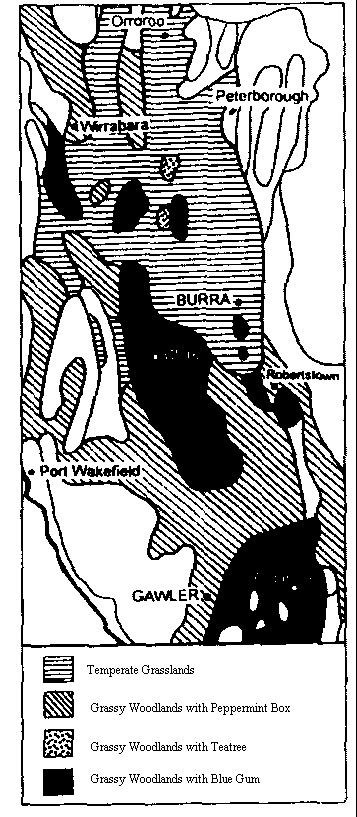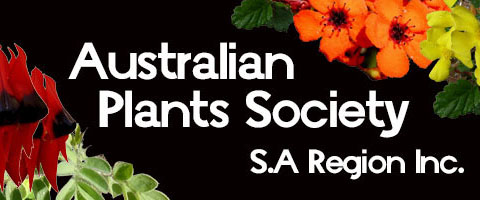Native Grasslands - PART 1: Our Forgotten Natural Gardens
from S.G.A.P Journal, August 1998, 14(7)
What is a Native Grassland?
Native grasslands are naturally-occurring areas that are covered with native grasses and their close relatives in the iron-grass, sedge, reed and rush families, and that have few or no trees. They can be ablaze with colour in spring, with daisies, lilies and other wildflowers. Grassy woodlands, on the other hand, are covered with the same range of native grasses and other low-growing plants, but with widely-scattered she-oaks, wattles, gums and native pines above them.
Native Grasslands are More Than Just Grasses!
To appreciate grasslands, you probably need to unlearn much of what you think you know about grass - which most people learn on the end of a lawn-mower or Weed Wand. Almost all native grasses are perennials and they have a tussocky habit. They may be up to a metre high when they are in flower. They do not produce runners to cover the whole ground surface.
Between the tussocks in a grassland there is 'bare ground' that is coveted with mosses, lichens and blue-green algae. Unlike the moss that you work to get rid of in suburban lawns, the moss in a grassland is a Good Thing. This is because, in this habitat, it holds the surface of the soil in place and recycles the nutrients. It also forms the open spaces where native reptiles and small native seed-eating birds such as finches and red-rumped parrots live and feed. In spring, in these inter-tussock spaces, a showy display of lilies, daisies and other wildflowers occurs.
Where do Native Grasslands Still Occur?
Almost all parts of Australia, including South Australia, have native grasslands as one of the local habitats. Estimates are that there is less than 2% of the original grasslands left, the rest having been ploughed for crops. There is almost no grassland in any public reserve system. Click to see full size map
The accompanying map of the Mid-North shows how widespread grasslands were in the Mid-North at the time of European settlement. Patches of grassland are still quite widespread on some properties, mainly in rough grazing areas. Most of these are still grazed. The best bits of grassland are often on public land such as Council reserves, especially if they have not been grazed.
In the south-east of the state, grasslands were once widespread. Two examples are the Box (Eucalyptus) and Buloke (Allocasuarina) grassy woodlands which covered parts of the Upper South-East, and the Gahnia tussock grasslands which were found between the limestone ridges of the Lower South-East.
The Adelaide Plains would also have had large areas of grasslands and grassy woodlands, as Darrell Kraehenbuehl records in his book Pre-European Vegetation of Adelaide: A Survey from the Gawler River to Hallett Cove.
Was it Really Native Grassland?
Near Adelaide, 1838: "...the land between the trees, which may be averaged as six or seven per acre, is covered with grass of the richest quality," "... the fact is, I believe, none of our colonists are (sic) learned in plants, and 1 at last got tired of asking the name of any flower I found - it was always an orchis (orchid)."
From: R. Gouger (1838), South Australia in 1837: in a series of letters, with a postscript as to 1838. Second Edition. Harvey & Darton, London.
Near the Broughton River in the Mid-North, June 27, 1840: "Our latitude at noon was 33deg. 25'26" S. Here, too, we found the first gum-trees seen upon any of the watercourses for many miles, as all those we had recently crossed, traversed open plains which were quite without either trees or shrubs of any kind."
From: Edward John Eyre (1845), Journal of Expeditions of Discovery into Central Australia and overland from Adelaide to King George Sound in the Years 1840-1. Volume I. T. & W. Boone, London. Facsimile Edition published by the Library Board of South Australia, Adelaide, 1964.
Keeping Our Grassland Wildflowers
It is important that we protect our few remaining areas of grasslands so that their showy display of lilies, daisies and other wildflowers can continue for their heirloom value as well as for nature conservation. Over 98% of all native grasslands are on private property and over 98% of these are grazed. The remaining 2% on public land has a disproportionately high conservation value because past management in these areas, particularly on low grazing regimes, has allowed for the retention of species with high conservation value and for the protection of species richness and diversity. Conservation on public land such as roadsides, Council reserves and old cemeteries can best be done if we:
- Value the grasslands and their diversity. Learn to recognise native grasses and grasslands so that they can be managed properly for their own values.
- Do not plough or spray areas such as roadsides. Grasslands do not recover from these activities.
- Stop tree-planting in grasslands. Trees can gradually eliminate the grassland species through shading and competition for moisture.
- Stop all fertilising. Fertilising promotes weedy annual grasses instead of natives.
- Let the grasses and wildflowers grow and set seed. Do not slash or mow them from early spring through to mid-summer.
Article by Ann Prescott and Millie Nicholls.
The Native Grasslands Project
Ann and Millie work on the South Australian Temperate Grassland Project, which is funded by the Natural Heritage Trust and supported by the World Wide Fund for Nature (WWF). The Native Grasslands Project is working with landholders, Local Government and other groups in the Mid-North to improve the condition of native grasslands, both to retain their grazing potential and for nature conservation. If you are interested in knowing more about native grassland or grassy woodland in the Mid-North, you can contact Millie Nicholls, or Ann Prescott, through The Australian Plants Society SA.



